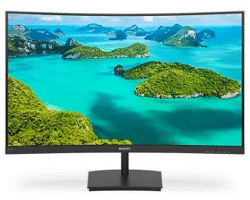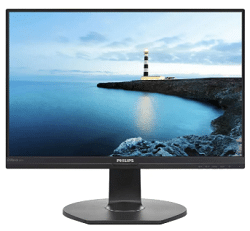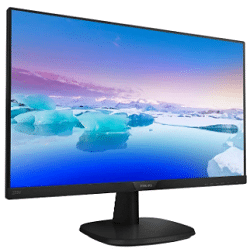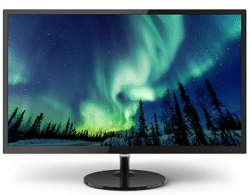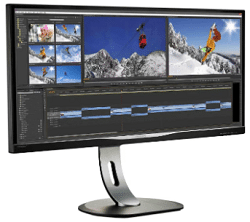Rating TOP-9 Philips monitors. Selection tips and an overview of the best models according to customer reviews
Computer monitor - what important characteristics to look for when choosing. Philips monitors - review and rating of models. Advantages and disadvantages according to reviews of real users.
If you are looking for good monitor for your PC, but you can't make up your mind - you've come to the right place!
This article is not only a review and rating Philips monitors, but also a small selection guide.
After reading it, you will learn about the diagonal, matrix, contrast, refresh rate and other characteristics of these devices.
Selection Tips
- diagonal.
For the office, 19-22 inches is recommended, for home (web surfing, video, simple games), 23.1-24 inch monitors are suitable.
For a long pastime, you should choose a larger diagonal (from 25 to 27 inches).
Avid gamers, designers and photographers will be more comfortable with displays with 28 inches or more;
- aspect ratio.
Popular formats 16:9, 21:9, some displays are curved to improve visibility and create an immersive effect; - screen resolution.
Full HD (1920x1080), the most suitable for the average user, Ultra HD (3840x2160) gives a more detailed image; - matrix type.
TN, cheap, but with poor color reproduction, IPS, more expensive, but with excellent light transmission and viewing angles, VA (MVA, PVA), average between TN and IPS in terms of performance and price; - pixel response time.
The smaller the better, for TN matrices it is the highest, for other types it is lower; - viewing angle.
For TN matrices, it is low, the angle for IPS is the highest (178 by 178 degrees vertically and diagonally); - frame refresh rate.
60 Hz (60 times per second) is enough to work and watch movies, for computer games it is better to choose a monitor with a refresh rate of 180 to 240 Hz.
Parameters such as monitor coverage, the ability to mount on a wall or table, a built-in speaker system, the presence or absence of certain ports are also important, they should not be neglected when choosing.
The best models in terms of price and quality ratio
It is impractical, to put it mildly, to have two or more monitors for different tasks.
Philips monitors are just such reliable, versatile and not too expensive devices.
A selection of the best models in terms of price and quality.
Philips 241E1SCA/00 23.6?
This monitor's curved display delivers fully immersive Full HD content with smooth transitions thanks to AMD FreeSync technology.
Philips 241E1SCA features high resolution and frame rate.
The frameless curved display is made on the basis of a high-quality matrix with wide viewing angles.
It has several video inputs, due to which it is possible to connect to the system unit of a computer, game console or laptop.
The desktop stand allows you to adjust the angle of the screen.
An interesting feature of the monitor is the use of Low Blue Light technology (muffles the intensity of blue).
Specifications:
- VA matrix;
- resolution 1920×1080 (16:9);
- frequency 76 Hz;
- response 4 ms;
- contrast ratio 3000:1;
- brightness 250 cd/m2;
- angles 178°?178°;
- ports HDMI? 2, VGA (D-Sub), audio-in, headphone jack;
- dynamics.
Advantages
- wide viewing angles;
- stand stability;
- uniform illumination;
- narrow bezels;
- many ports for connection;
- low price.
Flaws
- the sound of the built-in speakers is not up to par;
- unimportant black color, lights are observed in the dark (the problem is solved by setting).
Philips 272E1SA 27?
This device gives a stunning picture with crystal clear resolution, stylish practical body of the device fits perfectly into any workplace.
Model 272E1SA has wide viewing angles, accurate color reproduction and high image quality.
Other features include AMD FreeSync technology for smoothing dynamic scenes, SmartContrast for rich blacks, and a dedicated SmartImage gaming mode.
LowBlue technology reduces eye strain. The universal input allows you to connect a variety of digital devices.
Specifications:
- IPS;
- 1920?1080 (16:9);
- frequency 76 Hz;
- contrast ratio 1000:1;
- brightness 300 cd/m2;
- angles 178°?178°;
- HDMI, DisplayPort, VGA (D-Sub), audio-in, headphone jack;
- dynamics.
Advantages
- lack of glare, graininess;
- smooth movement of the picture, without loops;
- many ports;
- excellent brightness and contrast;
- level color depth.
Flaws
- small screen glare;
- no DisplayPort, audio cables included;
- built-in speakers sound bad.
Philips 241B7QUPBEB 23.8?
The USB-C connector onboard this monitor makes it easy to connect a laptop to it for fast data and video transfer, or simply charge an external device.
The display features thin bezels and the SmartErgoBase system for ergonomic placement and user convenience.
There is a flicker-free system and a LowBlue option that reduces the intensity of blue light. Philips 241B7QUPBEB has excellent color reproduction and wide viewing angles.
PowerSensor mode allows you to reduce energy costs.
Specifications:
- IPS;
- 1920?1080 (16:9);
- frequency 76 Hz;
- response 5 ms;
- contrast ratio 1000:1;
- brightness 250 cd/m2;
- angles 178°?178°;
- HDMI, DisplayPort, USB (video), VGA (D-Sub), audio, Ethernet, USB Type A?2, USB Type-C;
- dynamics.
Advantages
- high build quality;
- reliable comfortable stand;
- good color rendering;
- many setting modes.
Flaws
- ports are located at the bottom of the monitor, which is extremely inconvenient;
- high price.
Philips 223V7QSB/00 21.5?
The superb 21.5-inch wide display in a slim, compact design will impress with image quality and clarity, while special technology protects the user's eyes.
Several useful modes will make working at the monitor more comfortable.
These include Flicker Elimination, SmartImage Smart Image Adjustment, SmartContrast Black Saturation Adjustment, EasyRead Comfort Reading Mode, and LowBlue Blue Light Reduction.
Specifications:
- IPS;
- 1920?1080 (16:9);
- frequency 76 Hz;
- response 8 ms;
- contrast ratio 1000:1;
- brightness 250 cd/m2;
- angles 178°?178°;
- DVI-D (HDCP), VGA (D-Sub).
Advantages
- excellent color reproduction and brightness;
- wide viewing angles;
- low price;
- effective flicker-free technology.
Flaws
- unreliable latched stand, the monitor wobbles;
- few ports;
- no speakers;
- high response.
Gaming monitors
Choosing the perfect monitor for your computer is not an easy task. And it is doubly difficult to choose the best gaming machine. But not Philips.
Philips 327E8QJAB 31.5?
The advanced features of this affordable monitor will allow you to fully enjoy the game and get a vivid unforgettable experience.
The 327E8QJAB uses advanced technology to provide a wide viewing angle both vertically and horizontally.
Standard on Philips monitors, AMD FreeSync ensures smooth, stutter-free display at any frame rate and fast response times.
The display is distinguished by clear detail, high brightness and contrast, realistic color reproduction. The SmartContrast option analyzes the signal and adjusts the image contrast.
Specifications:
- IPS;
- 1920?1080 (16:9);
- frequency 75 Hz;
- response 4 ms;
- contrast ratio 1200:1;
- brightness 250 cd/m2;
- angles 178°?178°;
- HDMI, DisplayPort, VGA (D-Sub), headphone jack;
- dynamics.
Advantages
- bright, juicy, realistic picture;
- a high resolution;
- fast response;
- high refresh rate of lines and frames;
- affordable price for this class of monitors.
Flaws
- insufficiently rigid stand;
- weak sound of the built-in speakers;
- lack of a digital cable (HDMI, DisplayPort).
Philips 276C8 (276C8/00) 27?
Red Dot Design Award-winning ultra-slim model delivers QHD high-definition picture and USB-C cable connection without the hassle.
The device highlights the modern design of the ultra-slim body. Technologically, the monitor is also good.
The user can connect a laptop via USB-C if necessary, enjoy a rich color palette and high brightness of the image, experience all the benefits of high dynamic range (HDR) and the result of AMD FreeSync technology smoothing the gaming process.
Specifications:
- IPS;
- 2560?1440 (16:9);
- frequency 75 Hz;
- response 4 ms;
- contrast ratio 1000:1;
- brightness 350 cd/m2;
- angles 178°?178°;
- HDMI? 2, headphone jack, USB Type-C.
Advantages
- high resolution matrix;
- the presence of HDR;
- wide viewing angles;
- good color depth;
- light weight;
- external power supply.
Flaws
- high price;
- the bottom panel may seem too wide.
The best large models with a diagonal of 30 inches
You can fully appreciate all the benefits of ultra-high definition only on a monitor with a large diagonal.
Here the rule works: "The more - the better." You quickly get used to the large sizes of Philips monitors, and you don’t want to wean them at all.
Philips 328P6AUBREB 31.5?
Stunning QHD picture, secure connection, USB-C laptop charging, easy connectivity are just a few of the features this monitor has to offer.
The 328P6AUBREB features built-in USB-C docking station, high dynamic range, professional color standards (AdobeRGB, sRGB), 10-bit technology, wide viewing angles in all directions.
There is an Ethernet RJ-45 connector. The body of the device is made of PVC-free and BFR-free plastic.
Specifications:
- IPS;
- 2560?1440 (16:9);
- frequency 76 Hz;
- response 4 ms;
- contrast ratio 1200:1;
- brightness 450 cd/m2;
- angles 178°?178°;
- HDMI, DisplayPort, USB (video), VGA (D-Sub), audio-in, headphone jack, Ethernet, USB Type A?2, USB Type-C;
- dynamics.
Advantages
- good color rendering;
- excellent image clarity;
- lack of flicker and crystal-effect;
- comfortable and stable stand with lift.
Flaws
- inconvenient menu buttons;
- high price;
- menu settings are not flexible enough;
- slight uneven backlighting around the edges of the screen.
Philips 328E1CA 31.5?
A stylish curved display delivers an immersive experience, while ultra-sharp 4K UHD resolution, wide color gamut and Adaptive-Sync technology let you see the picture in every detail.
The solutions used will help you concentrate and not be distracted from watching a movie, work or play.
The LED display is equipped with an advanced multi-zone vertical alignment system for an ultra-high static contrast ratio.
The technology is responsible for a brighter and more vibrant picture.
A convenient cable management solution has been implemented, allowing you to work without unnecessary wires.
Specifications:
- VA;
- 3840?2160 (16:9);
- response 4 ms;
- contrast ratio 2500:1;
- brightness 250 cd/m2;
- angles 178°?178°;
- HDMI?2, DisplayPort, audio-in, headphone jack;
- dynamics.
Advantages
- illumination uniformity;
- matte screen finish without reflections and glare;
- high response;
- speed/quality setting "Faster".
Flaws
- crystal effect on the matte surface of the screen;
- the stand is unreliable, the monitor sways, it is not adjustable in height, there is no 90-degree turn;
- refresh rate 60 Hz;
- there is no auto-adjustment of brightness from the illumination of the room.
Philips BDM3470UP 34?
The widescreen display with MultiView mode allows you to view large-sized images in full detail and work with several applications or documents at once.
The monitor is equipped with a high-performance panel with a high pixel density and a wide viewing angle.
The UltraWide format allows you to visually compare several documents at the same time, view large tables with a large number of columns.
SmartUniformity mode maintains uniform brightness.
The monitor has an ultra-thin bezel and a secure stand with a close distance from the table for maximum reading comfort.
Specifications:
- AH-IPS;
- 3440?1440 (21:9);
- frequency 76 Hz;
- response 5 ms;
- contrast ratio 1000:1;
- brightness 320 cd/m2;
- angles 178°?178°;
- DVI-D (HDCP), HDMI, DisplayPort, VGA (D-Sub), audio-in, headphone jack, USB Type A?4, USB Type B;
- dynamics.
Advantages
- good color rendering;
- wide viewing angles;
- 3.5K resolution;
- semi-matte screen coating;
- high frequency;
- USB hub and fast charging technology;
- frameless design.
Flaws
- poor build quality;
- in light shades, the brightness “burns out”, requires additional hardware calibration;
- no USB-3 cable included;
- inconvenient menu management.
Reviews
This review has no replies yet.
conclusions
Philips monitors have a number of advantages compared to devices from lesser-known competitors:
- expanded color palette;
- availability of additional modes and options LowBlue, SoftBlue, AMD FreeSync;
- frameless design;
- affordable cost;
- there is not so much negativity in user reviews about the manufacturer's equipment (when compared with other brands).
Useful video
This video provides an overview of the 27 inch PHILIPS 276E9QJAB monitor:


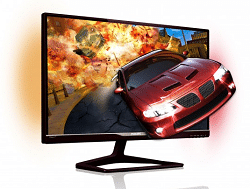 Avid gamers, designers and photographers will be more comfortable with displays with 28 inches or more;
Avid gamers, designers and photographers will be more comfortable with displays with 28 inches or more;